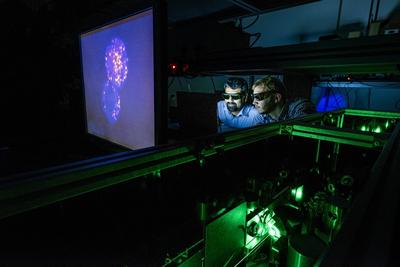Lighting the way to a healthy nation – optical ‘X-rays’ for walk through diagnosis & therapy

An interdisciplinary team of Scientists from the University’s School of Chemistry, Optoelectronics Research Centre (ORC) and Faculty of Medicine have been awarded a £2.4 million grant as part of an ambitious project looking to allow for rapid detection of disease using invisible light.
The research will look to develop hand-held devices that can be used in GP Surgeries and on hospital wards which enable doctors and nurses to see inside a patient’s body and provide fast diagnoses and considerable savings for the NHS. In the longer term, by 2050, the hope is that this technology can go even further, allowing the development of airport style scanners which can generate detailed 3D images of any patient with high resolution.
The project aims to replace the current imaging technology used by healthcare professionals which can provide diagnoses of disease but also come with limitations. MRI Scans provide detailed imagery for diagnosis but are expensive and require a contrast agent to be injected into the patient’s body which can be toxic. X-Rays are also a powerful diagnosis tool but can be dangerous and only show bones, whilst ultrasound is non-invasive but does not provide high resolution images.
Far-red ‘invisible’ light has the potential to provide clearer diagnostic information fast, and is benign so does not have any of the damaging effects of other technologies. However, current diagnostic light microscopy technology can only penetrate 1mm beneath a patient’s skin. The Southampton team are looking to build on the world-leading optical physics expertise in its ORC to develop lasers that can go to 5mm, deep enough to diagnose melanomas, and then to 10s of mm which would allow healthcare workers to look at joints and bones.
.jpg_SIA_JPG_fit_to_width_INLINE.jpg)
One of the challenges for this form of microscopy is that light at the blue end of the spectrum is more likely to “scatter”, which makes it difficult to focus on the target area. To compensate for this, the researchers are looking to use far-red lasers, which do not scatter as much and also to make use of artificial intelligence (AI) to reconstruct images.
In the early stages of the research, the team will test the products they develop on osteoporosis and osteoarthritis samples with the Faculty of Medicine. An aging population means bone disease is likely to become more and more prevalent and it has been estimated that diseases such as these will costs the NHS £50 billion per year by 2050.
The project will be led by Professor Mark Bradley from the University of Edinburgh and has received total funding of £6.8 million from the Engineering and Physical Sciences Research Council (EPSRC). The University of Southampton’s allocation of £2.4 million will be used to develop and test the imaging technologies, led by Professor Sumeet Mahajan, Professor in Molecular Biophotonics & Imaging in the School of Chemistry. University of Nottingham are also partners in the project.
Professor Mahajan, who leads the Imaging theme for the University’s Institute for Life Sciences said: “Getting an accurate diagnosis can be a lengthy process and very expensive, often requiring subsequent medical referrals, biopsies and exploratory surgery.
“Detecting diseases quickly, cheaply and without any invasive techniques will allow for faster treatment and better quality of life for patients as well as reducing the burden of a resource constrained NHS. The vision of contactless and damage-free diagnostic walk-through imaging by 2050 is achievable.”
Professor David Richardson, Deputy Director of the ORC adds: “The fibre lasers in this new range of far-red wavelengths has the potential to revolutionise medical imaging.”
Professor Richard Oreffo from the Faculty of Medicine commented: “The world leading technology developed at Southampton will be truly transformative for diagnosing bone ailments given the aging population.”
Work on the project is due to begin on 1st June. The Southampton team are members of the University’s Institute for Life Sciences. Life Sciences at Southampton breaks the traditional mould of solving problems within the confines of a discipline. We have an established reputation for working collaboratively, taking disruptive approaches and risk through interdisciplinary team science.